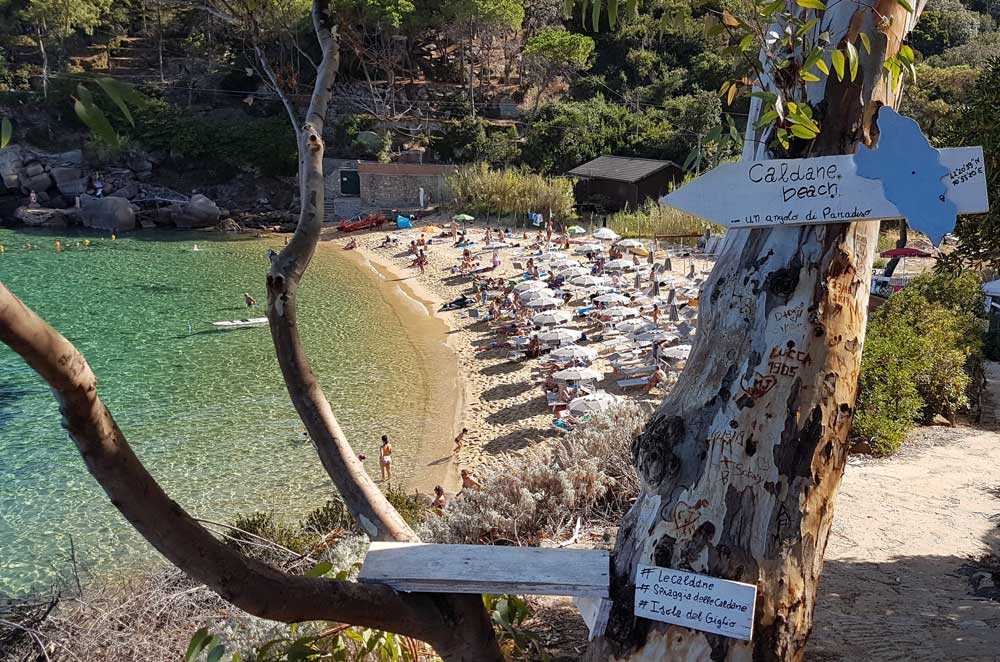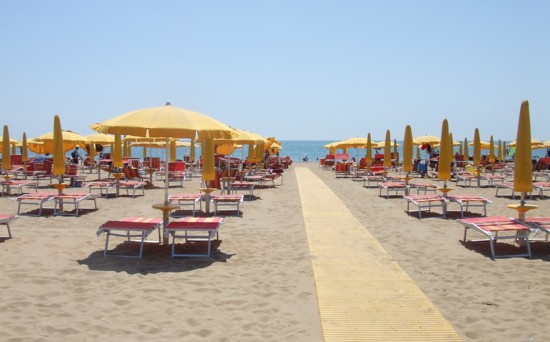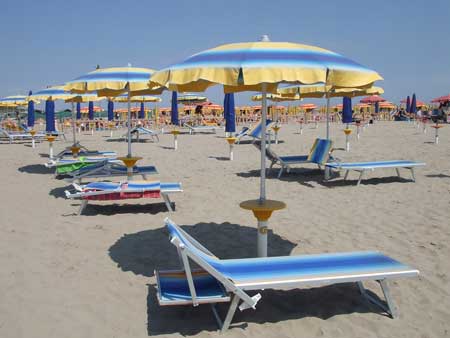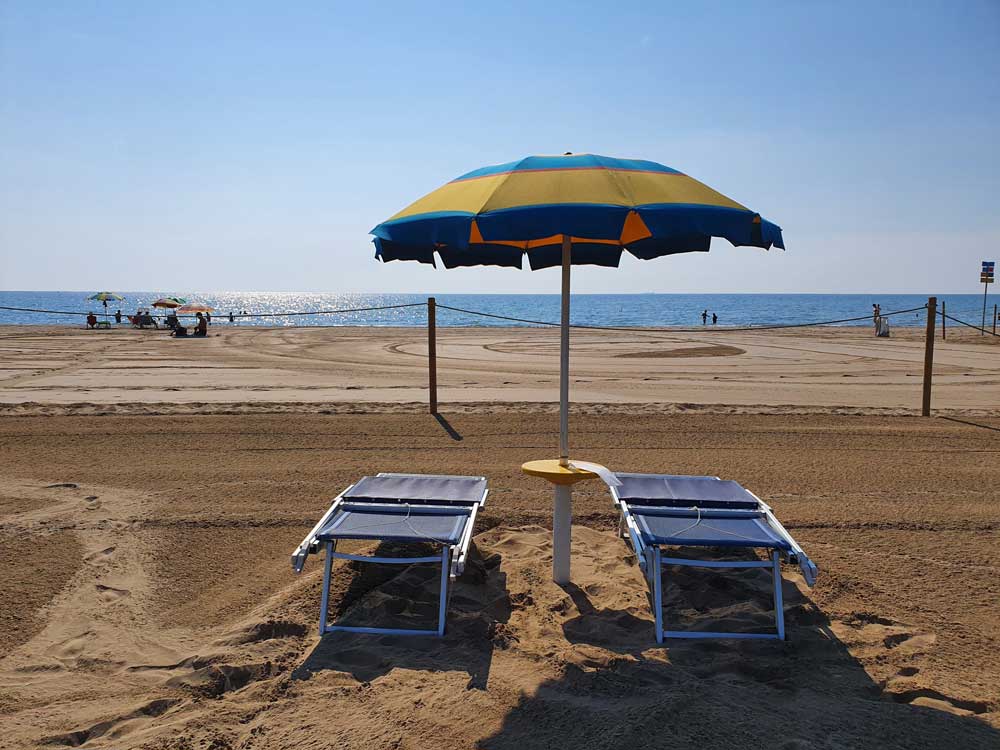Italy is famed for its glorious beaches, ranging from picturesque rocky coves to miles-long expanses of sandy beach resorts. There’s a beach for everyone, and in the summer the sea – il mare – becomes a kind of religion.
If you have happy memories of a childhood on the beach digging in the sand and running around on a wild English beach, you may find Italian beaches bewilderingly alien. Instead of expanses of sand, you’ll find rows of sunbeds, fences, gates and even discos. Even sand is optional, as long as there are sunbeds and sea or a pool. Here going to the beach is a national obsession and governed by strict rules. A very funny account of Italian beach customs can be found in Tim Parks’s book An Italian Education.
The biggest surprise for visitors is that beaches are mostly ‘private’. It can be very hard to gain simple access to the sea in summer months without paying an admission fee. If you don’t want to hire sunbeds and a place on the sand, you will need to look for a free beach.
Access to the sea
Access to the sea is a thorny issue in Italy. Every year protestors attempt to ‘reclaim’ beaches, and consumer articles complain about the price of beach holidays. Consumer groups insist that the law entitles everyone to access to the sea and to walk through private beach establishments if necessary, pointing out that these are beach ‘concessions’, not private property. They advise people to call the polizia municipale if they are refused access.
Conciliatory local authories claim that the provision of free beaches and publicising their whereabouts should be enough. Basically the law is not interpreted strictly and since local authorities make money from private concessions (and local officials might even own them), there is little motivation to improve the situation. What you find will depend on the locality and how rigorously laws are applied. You should be able to walk along the beach within a 10m strip from the water’s edge, and to pass through private establishments to get to the sea, but you may well find you are prevented from doing so. Short of calling the police, your best bet is to use a free beach instead.
Free beaches
A free beach – spiaggia libera – is usually signposted. It generally consists of a narrow stretch of beach close to the nearest road access, and is identifiable by the absence of beach infrastructure, (regimented sunbeds etc.) and by the presence of clusters of sunbathers lying on towels. There may be a bar nearby, or a stall selling cold drinks. Some free beaches are provided with showers and public toilets.
If you are visiting a free beach, bear in mind that these beaches, especially near cities (such as Ostia Lido near Rome) can be dirty, extremely crowded and not particularly pleasant. Take care of your possessions and beware of illegal pedlars. Some more distant stretches or remoter beaches may be much more pleasant – ask your hotel or a local for advice.
Away from the busy beach resorts there are hidden coves and isolated spots for sunbathing and swimming. Italian beach-lovers have their favourite spots and will often trek a long way or clamber over difficult rocky terrain to reach their chosen patch of sand or flat sea-edge rock. Sometimes these in-the-know destinations are more about swimming than lounging, though, and you won’t always find much sand or space.

Pay for comfort
For a comfortable beach stay, visitors could do as most Italians do, and hire a sunbed (lettino) and parasol (ombrellone). Seaside hotels often have a private beach, sometimes across a road from the hotel. Others may have arrangements with local private beaches. Note that even as a hotel guest you might still be expected to pay extra for the beach facilities: check in advance if it’s not clear. Some beach huts and sunbeds are hired by the week or by the season; some beach establishments are members’ clubs where locals come to sun themselves for a couple of hours a day.

Swimming
Swimming is a very popular activity and a way to cool down on a hot summer’s day. Busy and private beaches generally have lifeguards dressed in red, and signs indicating safe depths. Some beaches have dangerous currents, and every year Italy has a significant number of deaths from drowning. The presence of other swimmers isn’t enough to guarantee the safety of the water. Make sure you understand any signs displayed, and ask for advice if you have any doubts.
Tides are not very high, nor can the waves be compared to those of the UK’s rugged Atlantic beaches. There are, however, other threats lurking in the waters. Occasionally vast quantities of algae led to beaches being closed along Italy’s western coast. Jellyfish are common, and their stings can be painful.
Decency
Normal Italian standards of dress do not apply on the beach, although full nudity is kept for dedicated beaches which are generally unofficial and remote. However, as soon as you leave the sand, you should cover up. Swimming costumes, bikini tops and bare-chested men will give offence once you’re away from the beach.
Beach behaviour

Traditionally a typical Italian beach-going family might rent a flat for two months in a popular seaside resort like Rimini, Pescara or Lido di Jesolo. For part of that period, husbands may join the family group only at weekends, remaining at work during the week.The family pets will come along (I’ve even seen goldfish on the ferry to Ischia), and so might the grandparents. Half the family’s neighbours will also have transplanted themselves to the same resort. In the morning everyone heads to the beach, lying in rows on their sunbeds. At lunchtime they’ll return home to cook up a big family meal just like at home. In the afternoon it’s back to the beach again. And so on for weeks.
For young people there are bars on the beach, and evening discos and parties. These are generally neither selective nor classy: as we write this, Jesolo’s big attractions are ‘sexy wrestling’ and a beauty competition. There is a thriving nightlife along most urban stretches of beach, so summer holidaymakers shouldn’t expect tranquil midnight strolls. In Rome, many of the city’s nightclubs actually close for the summer, and transfer their operations to the seaside at Ostia or nearby. Naturally this nightly exodus of young people leads to traffic problems and alcohol-related accidents.
During the summer months by the sea, you can see Italian society at its most conformist and odd to outside eyes, with thousands of Italians in close proximity all following the same unwritten seaside rules. Despite the ready availability of sunshine, a suntan is still prized, with little care for health. Men, women and children all turn unfeasible shades of mahogany, helped by the tanning products which outnumber simple sunblock in the shops. In my first Italian winter it came as a great surprise to realise that Italians were fading to a skin colour like that of northern Europe. I wouldn’t recommend you join them: stock up on sun cream (latte solare) and avoid the day’s hottest hours.
Some sandy beaches:
> Rimini, Emilia-Romagna
> Sperlonga, Lazio
> Lido di Jesolo, Veneto
> Pesaro, Le Marche
and more:
> Seaside resorts – my guide to coastal destinations in Italy
> Best seaside holidays – a selection of the top destinations
> Coping with the heat
On this site
Lido di Jesolo (with sample beach prices)
Useful links
